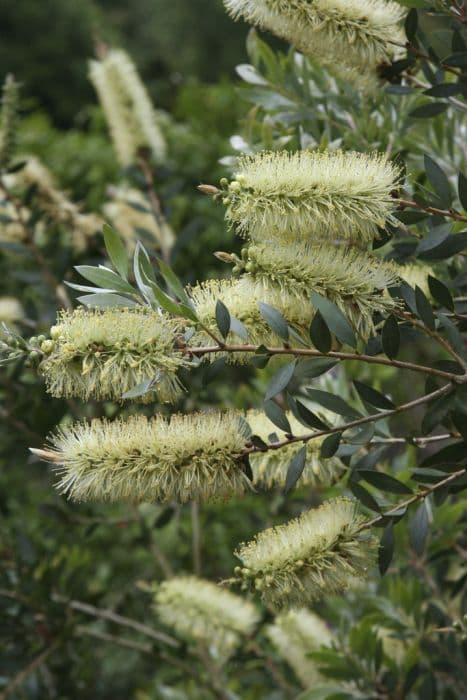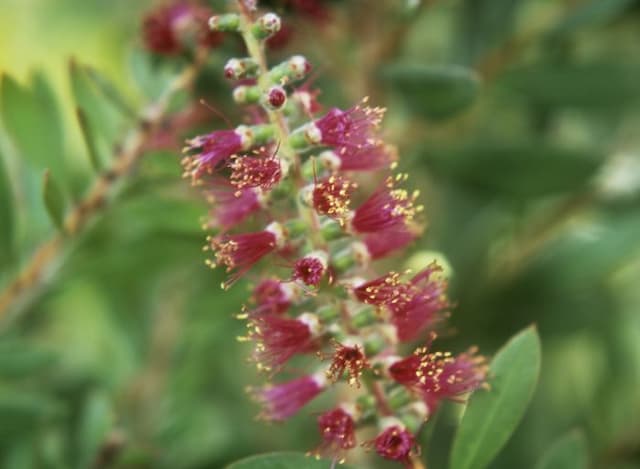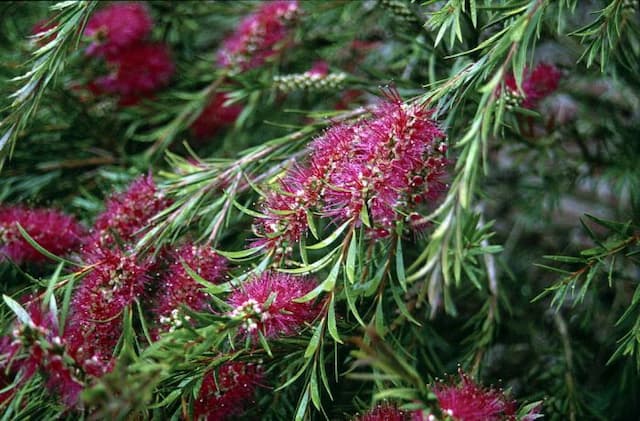Tarentum Myrtle Myrtus communis subsp. tarentina

ABOUT
Myrtus communis subsp. tarentina, better known as Tarentum myrtle, is an evergreen shrub with a dense and bushy appearance resulting from its multiple stems branching from the base. The foliage is composed of small, aromatic, glossy leaves that are dark green. These leaves are opposite on the stem and persist throughout the year, providing continuous greenery. The plant produces an abundance of delicate white flowers, each with a multitude of conspicuous stamens at their center that extend beyond the petals, giving the blooms a slightly fluffy appearance. After the flowering period, the Tarentum myrtle bears tiny, round berries that are blue-black when ripe. These fruits and the flowers are both supported by short stalks attached to the stems among the leaves. The overall texture of the Tarentum myrtle, combined with its greenery and the contrast between the stark white flowers and dark berries, makes it an attractive addition to gardens seeking year-round interest without requiring a large space for planting.
About this plant
 Names
NamesFamily
Myrtaceae
Synonyms
Myrtle, Tarentum Myrtle, Tarentum Myrtus, Taranto's Myrtus
Common names
Myrtus communis var. tarentina, Myrtus tarentina.
 Toxicity
ToxicityTo humans
Common myrtle (Myrtus communis) is not widely recognized as a significantly toxic plant to humans, and there is limited information on its toxicity. However, as with many plants, it is possible that some people might experience mild stomach upset or an allergic reaction if they ingest parts of the plant. It is always advisable to exercise caution and avoid eating any plant parts unless they are known to be safe for consumption. Symptoms of a potential allergic reaction could include skin rash, itching, or irritation, while ingesting the plant could potentially lead to gastrointestinal discomfort.
To pets
Common myrtle (Myrtus communis) is not commonly listed as a toxic plant to pets, such as cats and dogs. However, it should be noted that individual pets might have variations in sensitivity, and ingestion of the plant might lead to mild gastrointestinal upset in some cases. Symptoms could include vomiting or diarrhea. It is generally recommended to prevent pets from ingesting plants that are not confirmed to be safe, as even non-toxic plants can cause reactions in certain animals. If you suspect your pet has ingested common myrtle and is showing adverse symptoms, consult with a veterinarian.
 Characteristics
CharacteristicsLife cycle
Perennials
Foliage type
Evergreen
Color of leaves
Green
Flower color
White
Height
5 feet (1.52 meters)
Spread
5 feet (1.52 meters)
Plant type
Shrub
Hardiness zones
8
Native area
Mediterranean
Benefits
 General Benefits
General Benefits- Aesthetic Appeal: Myrtus communis subsp. tarentina, commonly known as Tarentum Myrtle, features attractive, glossy green leaves and star-shaped white flowers that enhance the visual appeal of gardens and landscapes.
- Fragrance: The flowers of the Tarentum Myrtle emit a pleasant fragrance, which can contribute to a sensory garden experience.
- Culinary Use: The berries of Tarentum Myrtle can be used as a spice, similar to juniper berries, adding flavor to various cuisines.
- Habitat for Wildlife: The plant provides a habitat and food source for pollinators like bees and butterflies, as well as birds that feed on its berries.
- Low Maintenance: Tarentum Myrtle is known for being a hardy and drought-tolerant plant, requiring minimal care once established, which makes it suitable for low-maintenance gardens.
- Erosion Control: This dense and robust shrub can help in stabilizing soil and preventing erosion, especially in sloped areas.
- Privacy Screen: With its dense growth habit, Tarentum Myrtle can be used as a natural privacy screen or hedge to create secluded areas in gardens.
- Traditional Uses: Historically, various parts of the plant, like leaves and flowers, have been used in traditional ceremonies and cultural practices.
 Medical Properties
Medical Properties- Antiseptic: Myrtus communis subsp. tarentina has been used for its potential antiseptic properties.
- Anti-inflammatory: The plant may possess compounds that help to reduce inflammation.
- Expectorant: It has traditionally been used to help clear respiratory passages.
- Astringent: The astringent quality of this plant has been utilized in folk medicine for toning the skin and mucous membranes.
- Antioxidant: It is believed to have antioxidant properties, which help in protecting cells from damage caused by free radicals.
 Air-purifying Qualities
Air-purifying QualitiesThis plant is not specifically known for air purifying qualities.
 Other Uses
Other Uses- Myrtle branches and leaves are used for religious and ceremonial purposes, especially in Jewish tradition during the festival of Sukkot where they are part of the Four Species.
- It is frequently used as a natural insect repellent when the leaves are crushed and essential oil is extracted.
- The aromatic quality of myrtle makes it a popular choice for perfumery and aromatherapy applications.
- Dried myrtle leaves and berries are occasionally used as a spice in cooking, adding a unique flavor to dishes.
- Myrtle wood, being hard and dense, is used in woodworking for making small decorative items like bowls, ornaments, and inlay work.
- In some cultures, myrtle is associated with love and is used in wedding bouquets or decorations to symbolize love and marriage.
- Historically, myrtle leaves have been used to tan leather due to the tannins present in the plant.
- As a potted plant, myrtle can be cultivated as a bonsai for ornamental purposes.
- Myrtle branches are used to craft musical instruments such as the flutes or the reeds for woodwind instruments.
- Essential oil derived from myrtle can be used as a natural fragrance for making soaps, candles, and other personal care products.
Interesting Facts
 Feng Shui
Feng ShuiThe Common Myrtle is not used in Feng Shui practice.
 Zodiac Sign Compitability
Zodiac Sign CompitabilityThe Common Myrtle is not used in astrology practice.
 Plant Symbolism
Plant Symbolism- Love: Myrtle, specifically Myrtus communis, has been a symbol of love and marriage in many cultures. It was often used in wedding ceremonies and bridal bouquets to signify the love and union between the bride and groom.
- Peace: The myrtle plant has also been associated with peace. In some traditions, it represents a peaceful home and tranquility within the family.
- Fertility: Due to its evergreen nature and the tendency to produce abundant fruits, myrtle is often considered a symbol of fertility and life.
- Chastity: In historical contexts, particularly in ancient Greece and Rome, myrtle was a symbol of chastity and purity, linked with goddesses such as Aphrodite and Venus.
- Immortality: The evergreen leaves of the myrtle plant signify immortality and the undying nature of the soul, reflecting the human desire for eternal life.
 Water
WaterFor a Tarentina myrtle, watering should be regular but moderate, aiming to keep the soil consistently moist without becoming waterlogged. During the growing season in spring and summer, water the plant deeply once a week using approximately 1-2 gallons of water, depending on the size of the plant and the pot. In the fall and winter, reduce watering to every other week, ensuring that the top inch of soil is dry before adding more water. Be sure to provide thorough watering that reaches the entire root system, but avoid letting the plant sit in standing water as this can lead to root rot.
 Light
LightTarentina myrtle prefers a bright spot with plenty of indirect sunlight. It thrives best in areas where it can receive at least several hours of indirect light each day, avoiding the intense midday sun which can scorch its leaves. An east or west-facing window with filtered light would be an ideal location for this plant.
 Temperature
TemperatureTarentina myrtle enjoys a warm climate and fares well in temperatures ranging from 50 to 80 degrees Fahrenheit. It can withstand a minimum temperature of 30 to 40 degrees but should not be exposed to freezing conditions. The ideal temperature for robust growth is between 60 and 70 degrees Fahrenheit.
 Pruning
PruningPruning Tarentina myrtle is necessary to maintain its shape and promote dense growth. The best time to prune is in late winter or early spring before new growth begins. Remove dead or diseased branches and thin out overgrown areas to improve air circulation. Pruning can be done annually, or as needed to shape the plant or manage its size.
 Cleaning
CleaningAs needed
 Soil
SoilThe best soil mix for Tarentina, also known as Tarentine myrtle, should be well-draining, with a mix of two parts peat moss to one part loam and one part sharp sand or perlite, maintaining a neutral to slightly acidic pH between 6.0 and 7.5.
 Repotting
RepottingTarentine myrtle should be repotted every two to three years to ensure healthy growth; younger plants may require more frequent repotting.
 Humidity & Misting
Humidity & MistingTarentine myrtle thrives best in moderate to high humidity levels, ideally between 50-60%.
 Suitable locations
Suitable locationsIndoor
Place Tarentine myrtle in bright, indirect light indoors.
Outdoor
Plant Tarentine myrtle in full sun to partial shade outdoors.
Hardiness zone
8-10 USDA
 Life cycle
Life cycleMyrtus communis subsp. tarentina, commonly known as Tarentum myrtle, begins its life cycle when seeds, typically dispersed by birds, germinate in moist, well-drained soil in a mildly warm climate. A seedling emerges, establishing itself with a deep taproot and beginning to grow into a bushy shrub with glossy evergreen leaves. Over the next few years, the plant matures and reaches reproductive age, where it produces fragrant white or pale pink flowers in late spring to summer, which are pollinated by insects, primarily bees. Following pollination, the flowers develop into purplish-black berries, containing the seeds for the next generation. Tarentum myrtle continues to grow and can reach up to 3-5 feet tall and wide; it's often pruned to maintain shape and encourage denser foliage for ornamental purposes. The plant has a long lifespan and can continue this reproductive cycle annually for many years, provided it's not subjected to freezing temperatures or other environmental stressors that could shorten its lifespan.
 Propogation
PropogationPropogation time
Spring-Early Summer
The most popular method of propagating Myrtus communis subsp. tarentina, commonly known as Tarentina Myrtle, is through semi-hardwood cuttings. This process typically takes place in the late summer. A healthy, non-flowering shoot is selected, and a cutting of about 4 to 6 inches (10 to 15 cm) is taken. The lower leaves are stripped, and the cut end is dipped into a rooting hormone to encourage root growth. The cutting is then planted in a well-draining potting mix, ensuring at least two nodes are buried where leaves were removed. It's crucial to maintain a humid environment for the cutting by covering it with a plastic bag or placing it in a propagator. The cutting should be kept in indirect light until roots have developed, which can be checked by gently tugging on the plant after a few weeks to feel for resistance.









